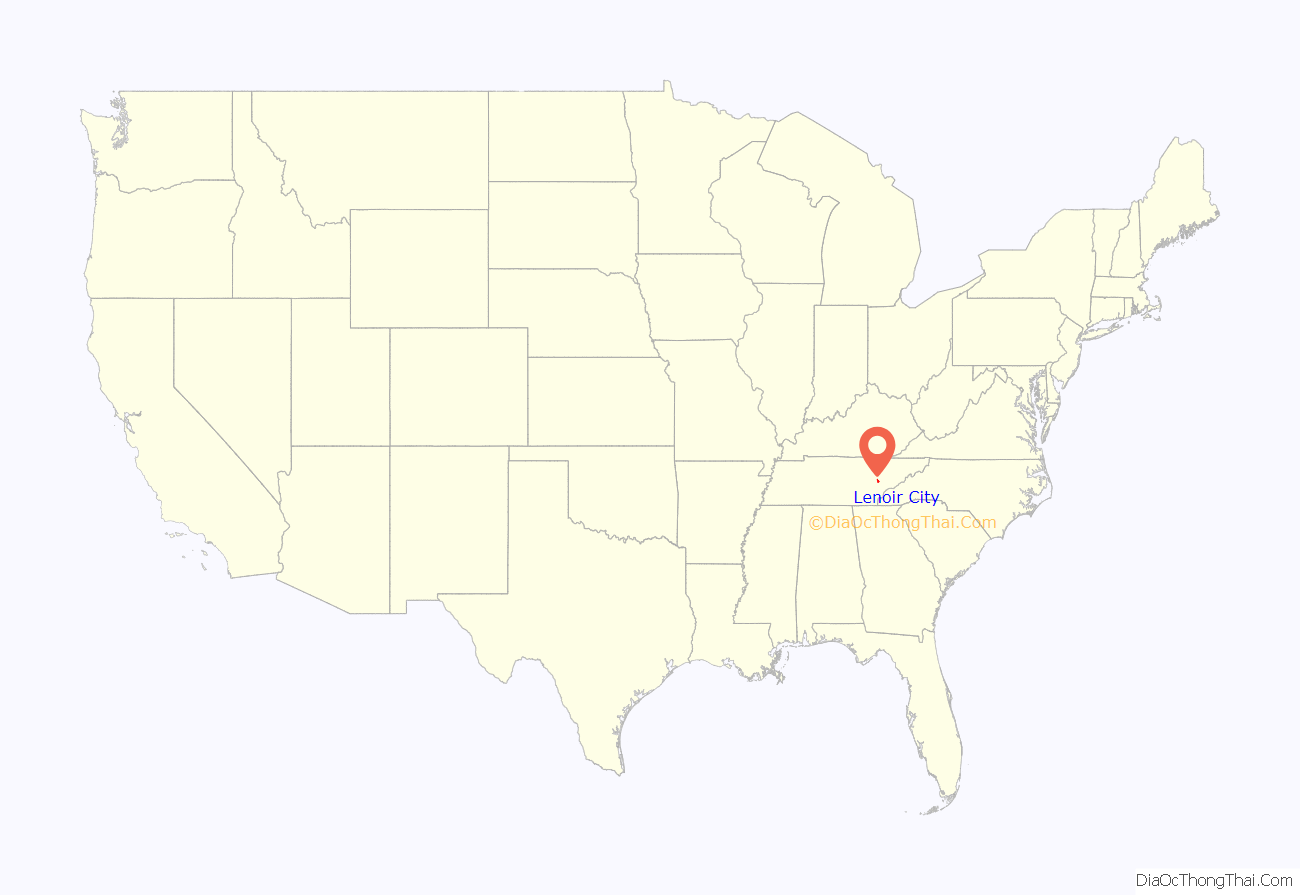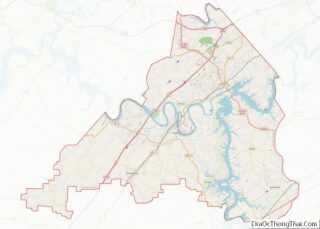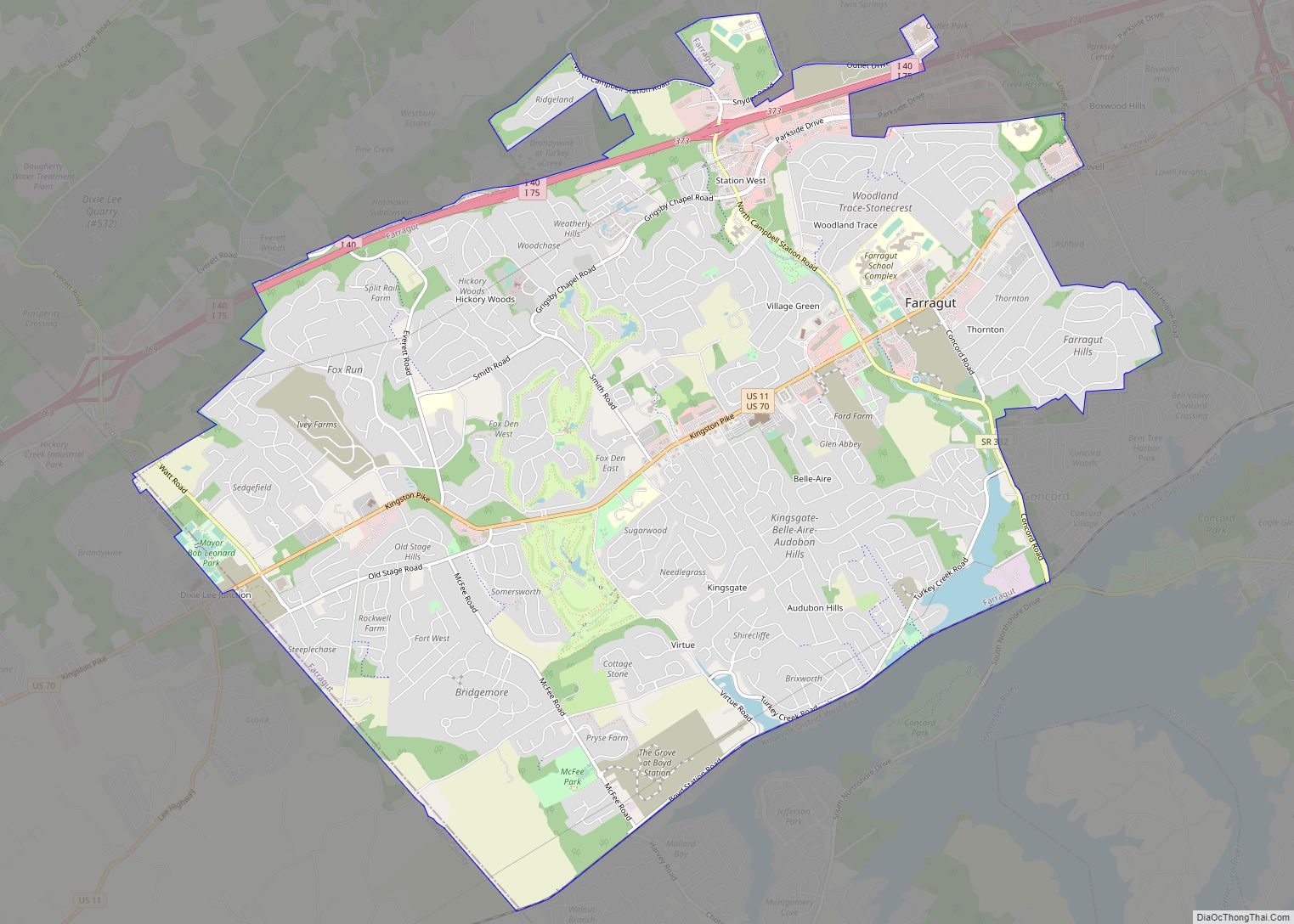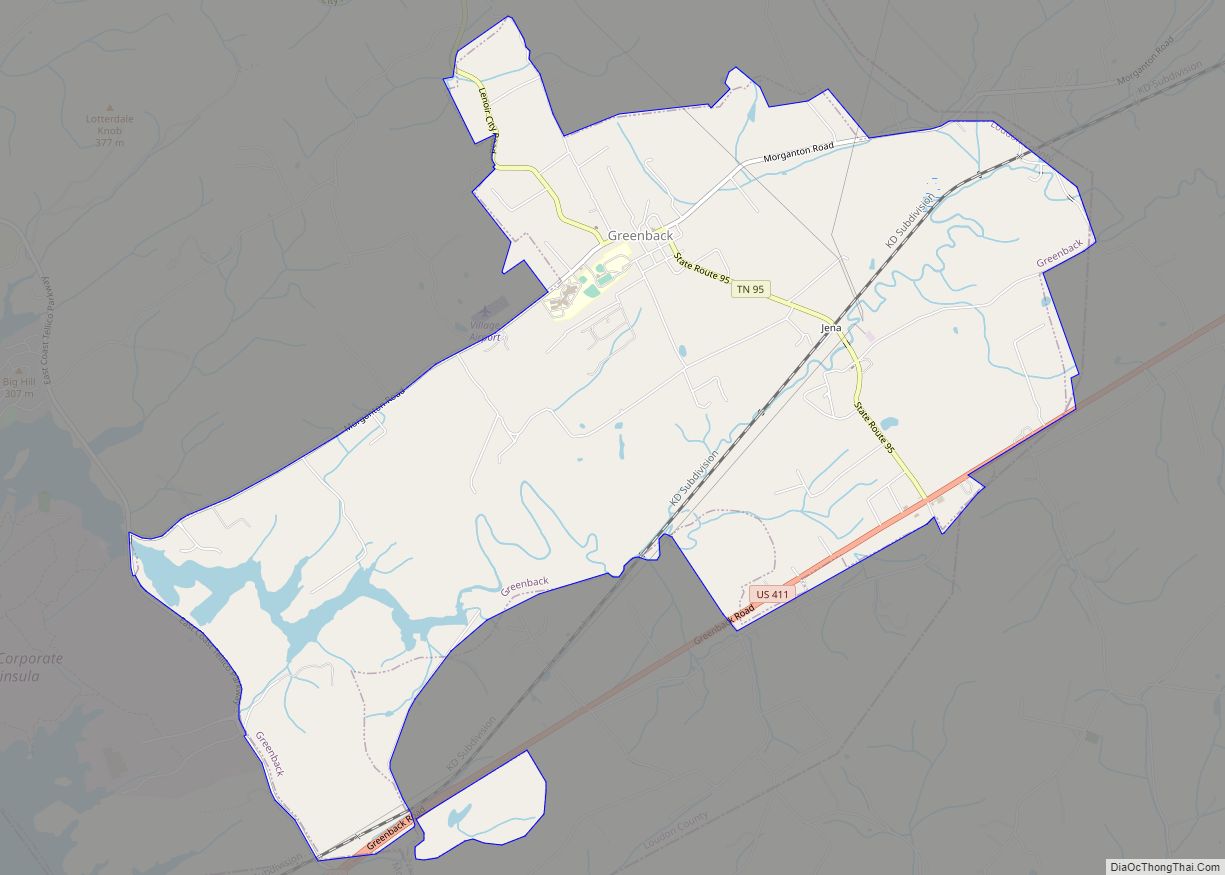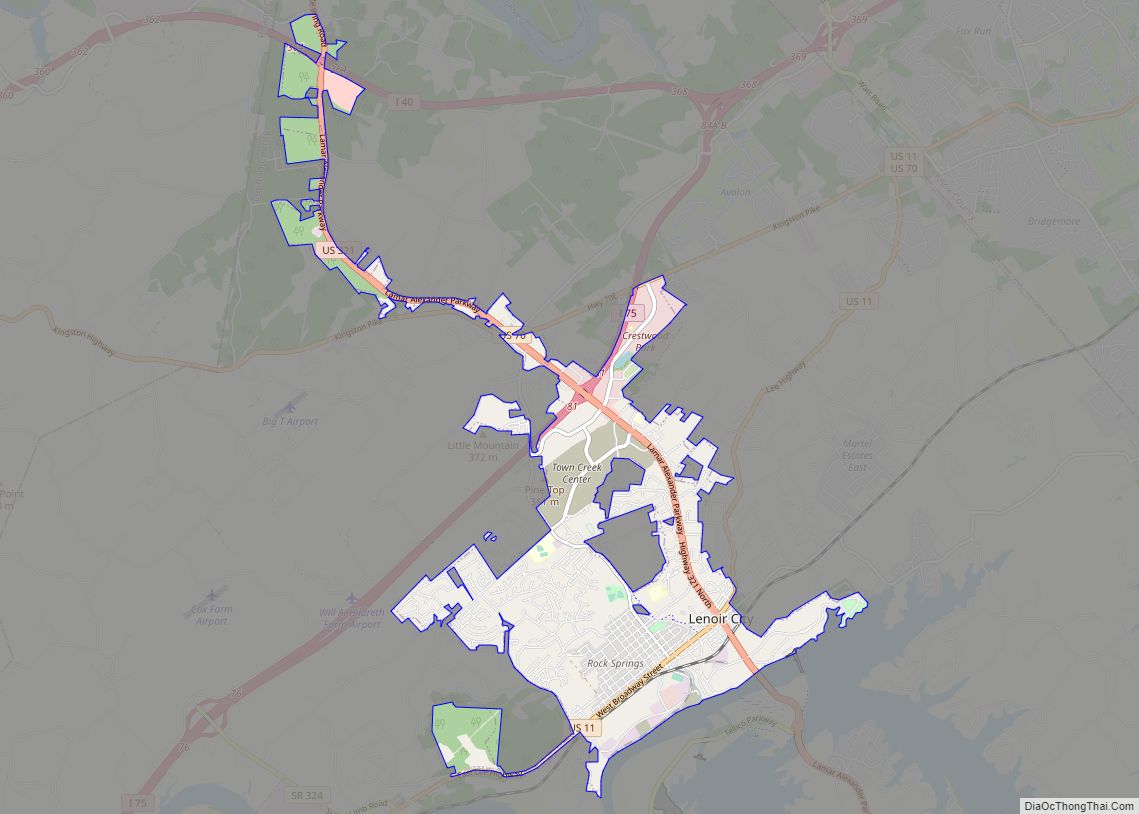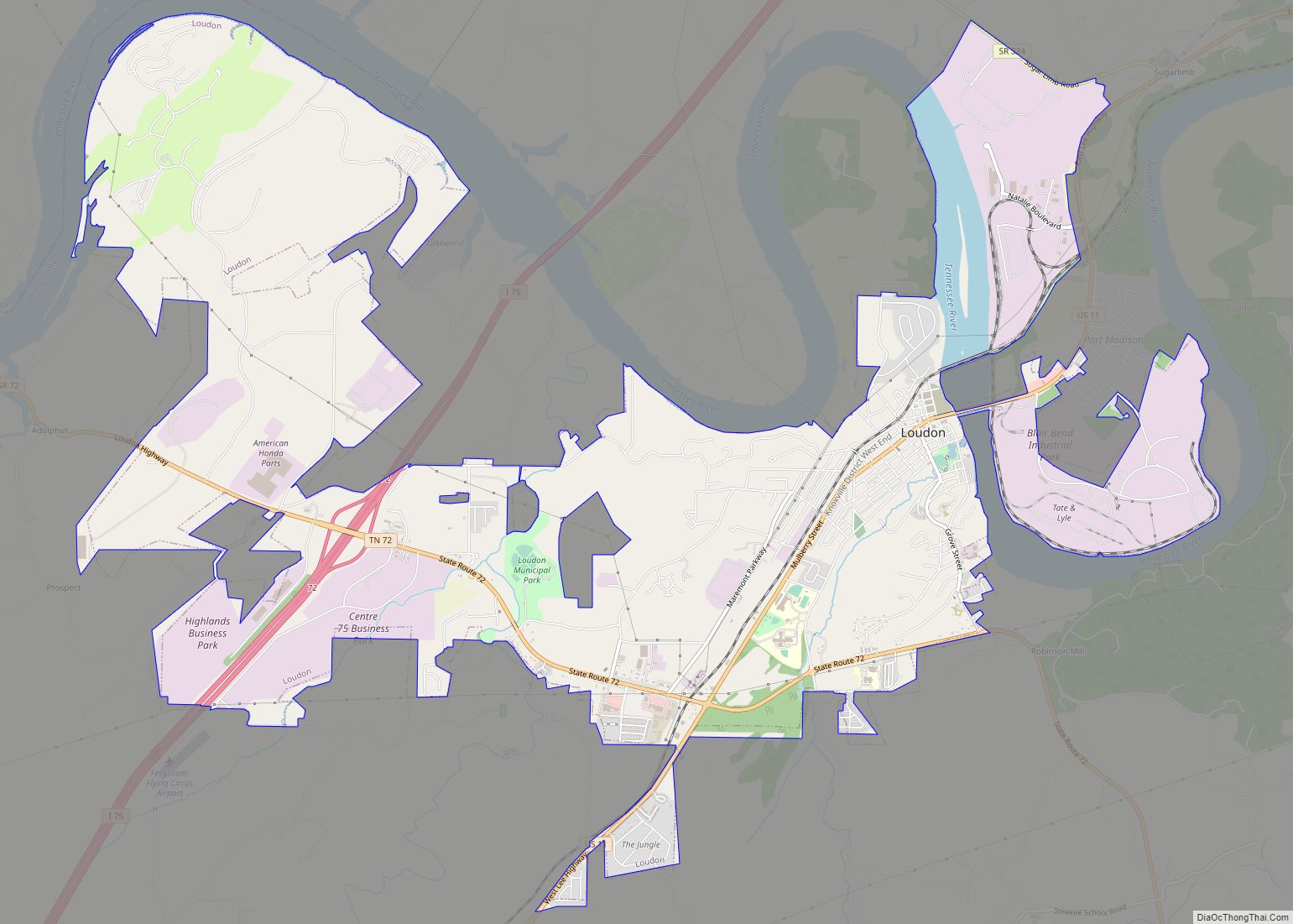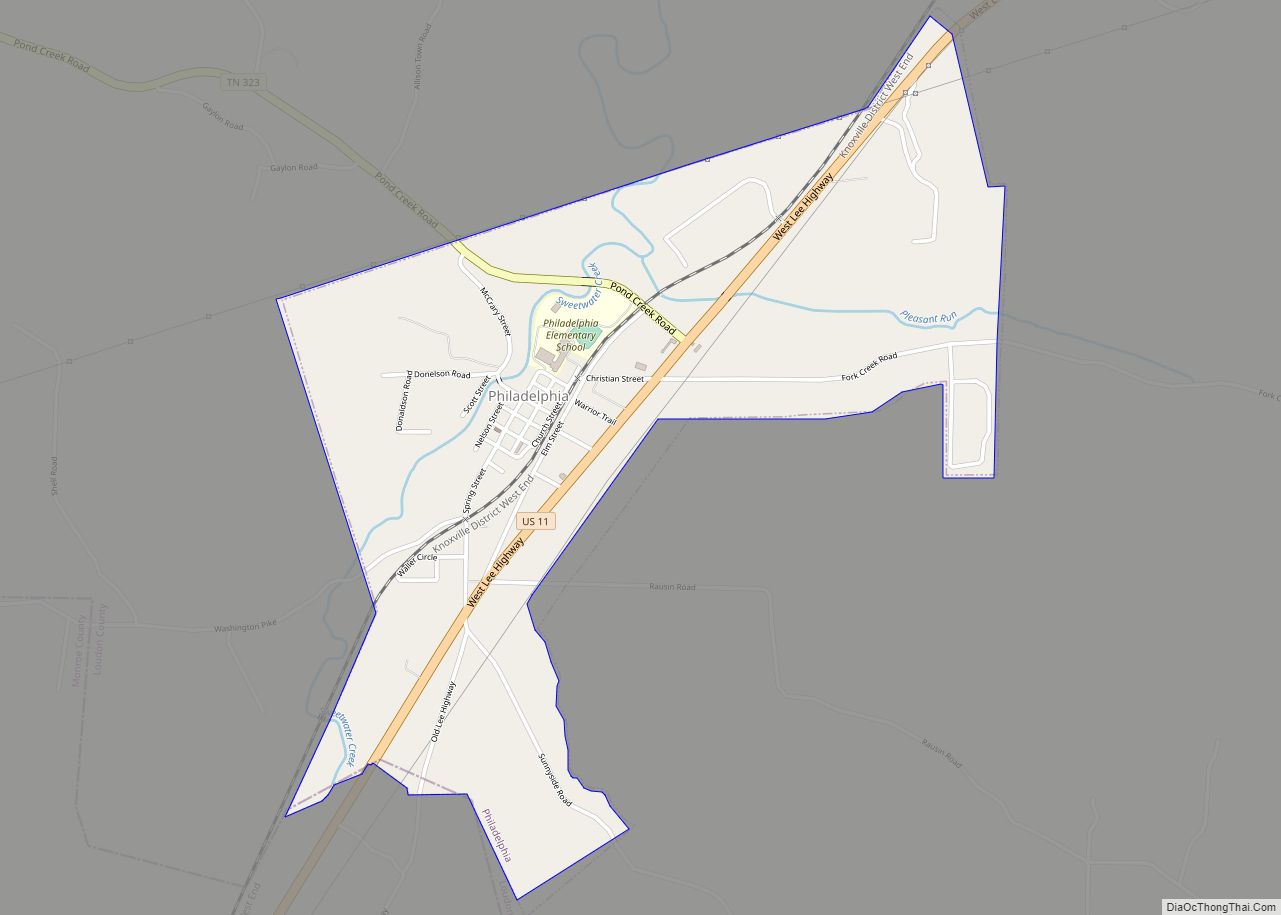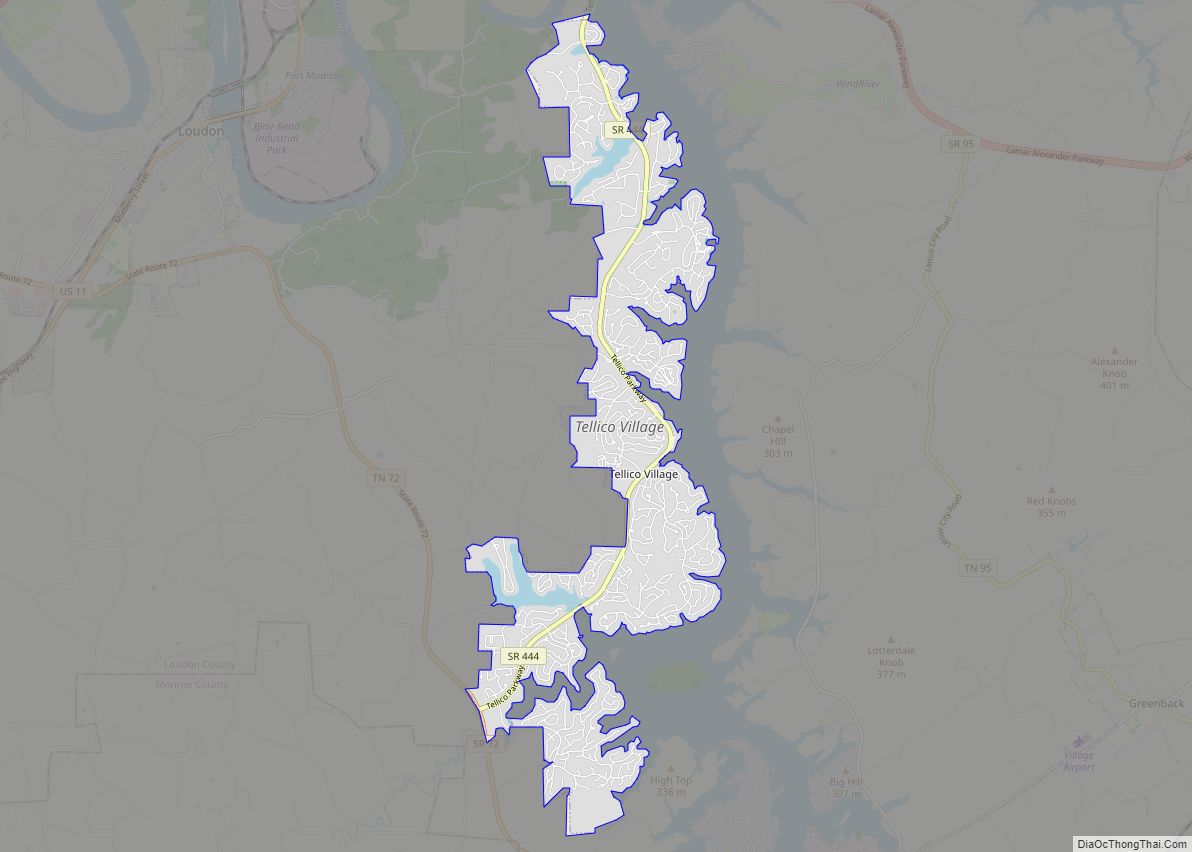Lenoir City is a suburban city located mostly in Loudon County, and partially in Roane County in Tennessee. The population was 10,117 at the 2020 Census. It is included in the Knoxville metropolitan area in the state’s eastern region, along the Tennessee River southwest of Knoxville.
| Name: | Lenoir City city |
|---|---|
| LSAD Code: | 25 |
| LSAD Description: | city (suffix) |
| State: | Tennessee |
| County: | Loudon County |
| Founded: | 1840 |
| Incorporated: | 1907 |
| Elevation: | 820 ft (250 m) |
| Total Area: | 8.63 sq mi (22.34 km²) |
| Land Area: | 8.63 sq mi (22.34 km²) |
| Water Area: | 0.00 sq mi (0.00 km²) |
| Total Population: | 10,117 |
| Population Density: | 1,172.85/sq mi (452.84/km²) |
| ZIP code: | 37771-37772 |
| Area code: | 865 |
| FIPS code: | 4741760 |
| GNISfeature ID: | 1291019 |
| Website: | www.lenoircitytn.gov |
Online Interactive Map
Click on ![]() to view map in "full screen" mode.
to view map in "full screen" mode.
Lenoir City location map. Where is Lenoir City city?
History
Native Americans were living in the Lenoir City area for thousands of years before the arrival of the first European settlers. On Bussell Island, which lies across the Tennessee River to the south, archaeologists have discovered evidence of habitation dating to as early as the Archaic Period (8000–1000 B.C.). The island is also believed to have been the location of “Coste”, a village visited by Spanish explorer Hernando de Soto in 1540.
The historic Cherokee called the Lenoir City area Wa’ginsi, and believed it to be the home of a large serpent that brought bad luck to anyone who saw it. By the early 19th century, an early East Tennessee pioneer, Judge David Campbell, had laid claim to part of what is now Lenoir City, where he built a log cabin and a gristmill.
In the early 19th century, the state of North Carolina granted General William Lenoir a 5,000-acre (2,000 ha) tract of land—which included what developed as Lenoir City—as payment for his services in the American Revolutionary War. David Campbell and another early settler, Alexander Outlaw, filed a case against Lenoir in court, arguing they had already laid claim to parts of the Lenoir tract.
After the case was settled in favor of Lenoir in 1809, Lenoir deeded the tract to his eldest son, William Ballard Lenoir (1775–1852). In 1810 the younger Lenoir moved to the tract with his wife and established a large plantation. His workforce was composed of enslaved African Americans. Lenoir’s agricultural enterprise included producing hams from a herd of Berkshire hogs. He also developed several small-scale industries, including a sawmill and flour mill. In the early 1830s, he built the Lenoir Cotton Mill—one of the earliest in the South—sited along the banks of Town Creek, a tributary of the Tennessee River.
After Lenoir’s death, his estate was divided among his children. His sons formed the William Lenoir and Brothers Company to manage the family’s businesses. When the railroad reached the Lenoir plantation in 1855, a depot was constructed. The community of Lenoir Station developed around it.
During the Civil War, the Lenoirs supported the Confederacy, due in part to associations with Confederate-leaning business interests in Knoxville. (One of Lenoir’s sons was married to the daughter of J. G. M. Ramsey, a Knoxville historian and banker, and an ardent Confederate). On June 20, 1863, a Union scouting expedition led by General William P. Sanders arrived at Lenoir Station after having failed to destroy the railroad trestle at Loudon. Sanders burned the depot and the Lenoirs’ sawmill and flour mill. He spared the cotton mill, because there were few such mills in the area to provide cloth for the army. In addition, both he and the Lenoirs were Masons.
Lenoir City Company
In the late 1880s, an abundance of financial capital, the popularity of social theories regarding planned cities, and a thriving coal mining industry in East Tennessee’s Cumberland Plateau region led to the development of a number of company towns to support coal mining throughout the Upper Tennessee Valley. Most of these were funded by investors from the Northeast or Knoxville.
In 1889, Knoxville railroad magnate Charles McClung McGhee and his friend and associate, Edward J. Sanford, formed the Lenoir City Company. They believed the Lenoir plantation would be the ideal location to develop such a town. The company incorporated in April 1890 with $800,000 in stock, and purchased the Lenoir estate, which then consisted of 2,700 acres (1,100 ha), for $300 per acre. When the company issued the stock to the public, the investors each received stock in the company and a lot in the planned town.
Lenoir City was laid out in a grid pattern with four quadrants, west of Town Creek and north of the railroad tracks. The city’s northwest quadrant was planned for middle class and affluent residents, whereas the northeast quadrant would be for the city’s wage-workers. The southwest quadrant would contain heavy industry, such as blast furnaces, steel works, and other large factories, while the southeast quadrant would contain woodworking, furniture, and canning factories. Influenced by late 19th-century reform movements that stressed health and temperance, the developers set aside several lots for public parks, and planned a large garden area was planned between the railroad tracks and the river.
The Lenoir City Company struggled due to a recession that froze financial markets in the early 1890s. By 1892, the company had sold only 144 of the town’s 3,448 lots. McGhee and Sanford persisted, however, and while Lenoir City never developed as fully as they had conceived, it survived. McGhee convinced a rail car company to open a factory in Lenoir City, and a short time later a knitting mill was established. Both establishments still employed several hundred workers in 1910.
20th century
Beginning in the 1930s during the Great Depression, a series of federal government projects provided a needed boost to Lenoir City’s economy and invested in regional infrastructure. The Tennessee Valley Authority’s construction of Fort Loudoun Dam and reservoir, which began in 1940, provided hundreds of locals with jobs. It also resulted in numerous road improvements, and generation of hydropower for electrification of the region.
In the 1950s and 1960s, construction associated with the Interstate Highway System resulted in building I-75 and I-40—two trans-national highways that intersect just northeast of Lenoir City. U.S. Highway 321 was built through Lenoir City in the 1980s primarily to provide greater access to the Great Smoky Mountains National Park, some 40 miles (64 km) down the road in Blount County.
On February 21, 1993, at 5:05PM, an F-3 tornado touched down in eastern Roane County (just west of town) and tracked east-southeast directly toward the city. The tornado devastated parts of the city. Parts of downtown, as well as the area near A Street and 5th Avenue, were destroyed. The Lenoir City High School/Middle School property suffered major damage (it was redeveloped as River Oaks Place). The tornado continued east-southeastward, going through the town of Friendsville before lifting in western Maryville. The death toll was one (in Lenoir City) and 55 people were injured, per the NWS Tornado Database.
In March 1998, a historic landmark, the William B. Lenoir Hotel, the block of Broadway (US 11) between A and B streets, was destroyed by a massive fire. The entire block was lost as it had been built with a common attic and basement, meaning there were no firewalls between buildings. Wilburn’s Barbershop, the Lenoir City Public Library, a Mexican grocery, offices for TV Readers magazine and Habitat for Humanity, a school photography company and photo finishing lab, and several apartments, were all destroyed by the blaze. This block was redeveloped for Roane State Community College, Tennessee Career Center, and a new Lenoir City Public Library.
21st century
In the early 2000s, Lenoir City’s economy expanded. New businesses developed along U.S. Highway 321, where new franchise restaurants, such as Ruby Tuesday, Chili’s, Cracker Barrel, Aubrey’s, and Zaxby’s, were added. New stores included Home Depot, Goody’s Family Clothing (now defunct), Cato, and Blockbuster Video (also defunct). A new hospital, Fort Loudoun Medical Center, was built to replace the old Fort Sander’s Loudon Hospital in nearby Loudon.
In the late 2000s, two major commercial developments were announced. Creekwood Park is located parallel to I-75 between US-321 and US-70. A new four-lane road was built between the two highways. A luxury apartment complex was built on part of the site. In 2014, business development finally started in the area, with a few medical offices completed. From 2016 to 2017, the city constructed a new community center called “The Venue”, and a new headquarters here for the Lenoir City Utilities Board here.
Dr. Bob Overholt, a local physician and TV personality, announced another development: The Market at Town Creek, planned to connect US-321 and Harrison Road near the Lenoir City High School and Middle School property. New businesses there include a Food City grocery store, Bojangles restaurant, Knoxville TVA Employees Credit Union, AT&T Store, Pizza Hut, and a tanning salon. In 2013 Town Creek Parkway, a four-lane road connecting US-321 and Harrison Road, was completed.
In 2016, the city inaugurated its first female city councilwoman, Jennifer Wampler. She was appointed to complete the remainder of the term vacated by the death of her late husband, Harry Wampler.
Lenoir City Road Map
Lenoir City city Satellite Map
Geography
Lenoir City is located at 35°47′51″N 84°16′16″W / 35.79750°N 84.27111°W / 35.79750; -84.27111 (35.797618, -84.271103). The Tennessee River and TVA’s Fort Loudoun and Watts Bar reservations provide the city’s southern boundary. Four major federal highways pass through Lenoir City: U.S. Route 11, which runs roughly parallel to the river shore, traverses the city east-to-west; U.S. Route 321, which crosses Fort Loudon Dam south of the city, traverses the city north-to-south. Interstate 75 and U.S. Route 70 intersect US-321 in the northern part of the city. I-75 provides access to the city from exit 81, and leads northeast 26 miles (42 km) to downtown Knoxville (via a connection with I-40), and southwest 91 miles (146 km) to Chattanooga. U.S. 321 runs through the center of town from southeast to northwest, leading northwest seven miles (11 km) to I-40 at exit 364 (the highway’s northern terminus), and east twenty miles (32 km) to Maryville. U.S. 70 runs to the north of the city, leading northeast nine miles (14 km) to Farragut and northwest 19 miles (31 km) to Kingston. U.S. 11 runs through the center of the city, leading northeast to Farragut and Knoxville, and southwest seven miles (11 km) to the city of Loudon.
Lenoir City is traditionally spread out along US-11, west of the road’s junction with US-321. This section of the city still roughly follows a grid plan laid out in the 1890s. In recent decades, Lenoir City has annexed a 5-mile (8.0 km) corridor of land along US-321 between its US-11 intersection and I-40 intersection. This corridor contains the city’s newer, commercial area which caters to the high volume of traffic brought to the area by I-75 and I-40.
See also
Map of Tennessee State and its subdivision:- Anderson
- Bedford
- Benton
- Bledsoe
- Blount
- Bradley
- Campbell
- Cannon
- Carroll
- Carter
- Cheatham
- Chester
- Claiborne
- Clay
- Cocke
- Coffee
- Crockett
- Cumberland
- Davidson
- Decatur
- DeKalb
- Dickson
- Dyer
- Fayette
- Fentress
- Franklin
- Gibson
- Giles
- Grainger
- Greene
- Grundy
- Hamblen
- Hamilton
- Hancock
- Hardeman
- Hardin
- Hawkins
- Haywood
- Henderson
- Henry
- Hickman
- Houston
- Humphreys
- Jackson
- Jefferson
- Johnson
- Knox
- Lake
- Lauderdale
- Lawrence
- Lewis
- Lincoln
- Loudon
- Macon
- Madison
- Marion
- Marshall
- Maury
- McMinn
- McNairy
- Meigs
- Monroe
- Montgomery
- Moore
- Morgan
- Obion
- Overton
- Perry
- Pickett
- Polk
- Putnam
- Rhea
- Roane
- Robertson
- Rutherford
- Scott
- Sequatchie
- Sevier
- Shelby
- Smith
- Stewart
- Sullivan
- Sumner
- Tipton
- Trousdale
- Unicoi
- Union
- Van Buren
- Warren
- Washington
- Wayne
- Weakley
- White
- Williamson
- Wilson
- Alabama
- Alaska
- Arizona
- Arkansas
- California
- Colorado
- Connecticut
- Delaware
- District of Columbia
- Florida
- Georgia
- Hawaii
- Idaho
- Illinois
- Indiana
- Iowa
- Kansas
- Kentucky
- Louisiana
- Maine
- Maryland
- Massachusetts
- Michigan
- Minnesota
- Mississippi
- Missouri
- Montana
- Nebraska
- Nevada
- New Hampshire
- New Jersey
- New Mexico
- New York
- North Carolina
- North Dakota
- Ohio
- Oklahoma
- Oregon
- Pennsylvania
- Rhode Island
- South Carolina
- South Dakota
- Tennessee
- Texas
- Utah
- Vermont
- Virginia
- Washington
- West Virginia
- Wisconsin
- Wyoming
